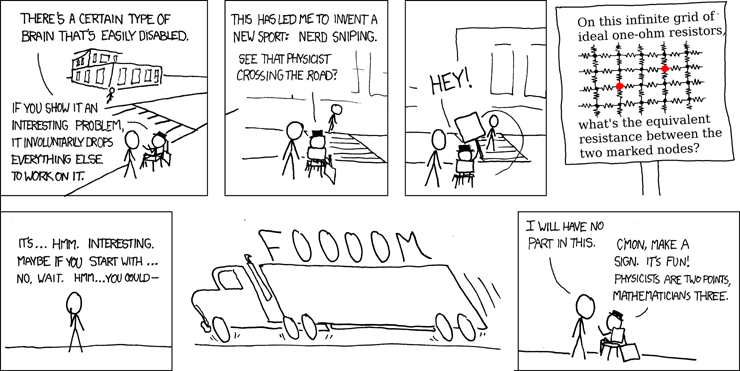
https://xkcd.com/356/
Welcome to my pages
I am doing some research on quantum materials, which is probably the
best opportunity to study a wide range of quantum mechanical phenomena,
integrating many distinct concepts from different areas of theoretical
physics. Be it compound-nuclear reactions or cosmology, quantum
electrodynamics or classical physics, the underlying theoretical tools have
found their way to the description of quantum materials, sometimes in
an unexpected manner.
The fascination of many-body quantum theory lives from a few key
ingredients. Most important: Identical particles, in particular many of
them. Due to their non-distinguishability, they behave completely
different, unexepected, and often counter-intuitive. This has surfaced
already in the 19th century, most prominently in the form of the so-called
mixing entropy, an increase in entropy when mixing two homogeneous,
single-phase materials which is absent when these materials are identical.
This absence is a purely quantum-mechanical phenomenon, also known as the
Gibbs paradoxon, named after Josiah Willard Gibbs (1839–1903).
Also any form of magnetism emerges from quantum mechanics and cannot be
understood classically. The Bohr-van-Leeuwen theorem tells us that if we
require that electrodynamic processes in nature are invariant with respect
to local U(1) gauge transformations (like Maxwell’s equations are),
magnetism cannot exist within the framework of classical statistical
mechanics. This applies to the longest-known form of magnetism, a
ferromagnet, as well as to its modern cousins.
Frustrated magnetism: route to new exotic phases
We concentrate our research on frustrated magnetism, that is magnetic
systems «not knowing what to do», given the highly (quasi-)degenerate
ground state manifold and low-energy excitations inherent to these. An
assembly of interacting spin S = 1/2 objects is prototypical, having the
advantage of the possibility to explore these systems numerically on
today’s computers. This is absolutely necessary, because traditional
theoretical methods simply fail to give a decent physical understanding and
at best can only simulate certain properties. We advance the numerical
methods to describe frustrated magnets in a systematic way, nonetheless we
use a variety of analytical tools to complement the numerical results in
order to get a complete picture.
We work closely together with experimental physicists. Our goal is to
advance the accurate numerical description of in particular magnetic and
magnetocaloric measurements to give insight into these and to guide the
experiments towards the discovery of new quantum phases. Over the last
years we have implemented code to achieve this which is world-leading in
the approximation-free evaluation of the corresponding partition functions
and cumulants we use to express thermodynamic and magnetocaloric
properties.
Excursion: hydrodynamic description of electron transport
Essentially unrelated to magnetism, we had a look at how we can contribute to the understanding of unusual transport properties in some ultrapure, layered metallic materials.
Conventionally, electronic transport is regarded as a dissipative process
where electrons lose their phase coherence via momentum relaxing collisions
when travelling through a conducting sample. The corresponding theoretical
descriptions of electronic resistance are based on this assumption,
typically regarding momentum conserving processes as well as boundary effects as unimportant. However
Boltzmann’s fundamental transport equation does not exclude these momentum
conserving processes at all, leaving room for a hydrodynamic theory of
electronic resistance.
High-purity samples and the focused-ion beam technology make it possible to
study such hydrodynamic effects experimentally. We support the experiments
with a semiclassical theory of the electronic transport which can
successfully describe the behavior of the resistance, in particular its
dependence on the sample geometry. And we do this with materials having a
lot of electrons, not with low-density conductors having just a few charge
carriers like the obvious candidate graphene.